Make California Alta again!
If Mexico builds a Wall it will be along the 1830 Border!
Wednesday, August 31, 2016
Tuesday, August 30, 2016
Campesinos, Vaqueros, Caballeros y Luchadores
Robert Mizer
Los Angeles CA
circa 1955-85
I can’t pretend to know the exact dates on these pictures but they’re mostly from the sixties, though the ones of Brian Diaz and Eddie Perez are both from the early eighties. Mizer often used hats as keys to ethnicities, since there tends to be little other costume other than foot gear and posing straps; and ethnicity was clearly one of his central concerns, as well as codes, symbols and keys.
Los Angeles CA
circa 1955-85
I can’t pretend to know the exact dates on these pictures but they’re mostly from the sixties, though the ones of Brian Diaz and Eddie Perez are both from the early eighties. Mizer often used hats as keys to ethnicities, since there tends to be little other costume other than foot gear and posing straps; and ethnicity was clearly one of his central concerns, as well as codes, symbols and keys.
Monday, August 29, 2016
the Mermaid, the Werewolf and the Mud Bath
Normal Love
Jack Smith
Old Lyme CT 1963
Since I’ve found a better source for frame enlargements or screen captures from Normal Love, I figured it would be nice to look at a short section of a favorite sequence in detail. Here Eliot Cukor is just beginning to smear Mario Montez with that very black mud they found near the shore in Connecticut. Below he can be seen falling backward while trying a lift, thoroughly coating her with muck, and finally beaming his charming smile directly into the eye of the viewer.
Since I’ve found a better source for frame enlargements or screen captures from Normal Love, I figured it would be nice to look at a short section of a favorite sequence in detail. Here Eliot Cukor is just beginning to smear Mario Montez with that very black mud they found near the shore in Connecticut. Below he can be seen falling backward while trying a lift, thoroughly coating her with muck, and finally beaming his charming smile directly into the eye of the viewer.
Sunday, August 28, 2016
White Heat
Raoul Walsh
Hollywood CA 1949
This was to be the last of Cagney’s gangster roles, so they decided to pull out all of the stops and bring the whole thing crashing down at the end. Between his migraine headaches, epileptic fits and intense fixation on his mother, in Cody Jarrett, with Cagney’s encouragement, Walsh and his screenwriters set about creating the most unlikely hero thus far presented in this already twisted genre. Once his mom gets shot in the back, Cagney’s character transfers his trust and worship to fellow inmate and savior, Vic Pardo (played by Edmond O’Brien, whose character is really an undercover agent, Hank Fallon, placed in Cody’s prison cell for this very purpose.)
However, it isn’t only in its emotional and psychological aspects that this film rises to extraordinary heights. Raoul Walsh was clearly fascinated by all the new gadgets to which the police had access in the wake of WWII. The film has almost a science fiction quality at times, while at others it comes close to documentary. Frame by frame the film is strikingly composed; and it’s ironic, given that Walsh had only one eye and so no depth perception, that his films exploit and exalt extreme deep focus cinematography as the work of few others have.
Hollywood CA 1949
This was to be the last of Cagney’s gangster roles, so they decided to pull out all of the stops and bring the whole thing crashing down at the end. Between his migraine headaches, epileptic fits and intense fixation on his mother, in Cody Jarrett, with Cagney’s encouragement, Walsh and his screenwriters set about creating the most unlikely hero thus far presented in this already twisted genre. Once his mom gets shot in the back, Cagney’s character transfers his trust and worship to fellow inmate and savior, Vic Pardo (played by Edmond O’Brien, whose character is really an undercover agent, Hank Fallon, placed in Cody’s prison cell for this very purpose.)
However, it isn’t only in its emotional and psychological aspects that this film rises to extraordinary heights. Raoul Walsh was clearly fascinated by all the new gadgets to which the police had access in the wake of WWII. The film has almost a science fiction quality at times, while at others it comes close to documentary. Frame by frame the film is strikingly composed; and it’s ironic, given that Walsh had only one eye and so no depth perception, that his films exploit and exalt extreme deep focus cinematography as the work of few others have.
Subscribe to:
Posts (Atom)































































































